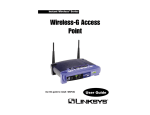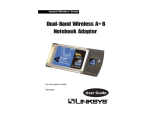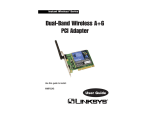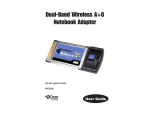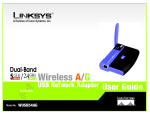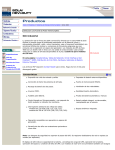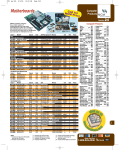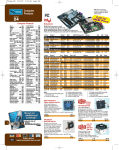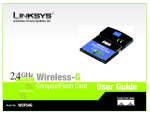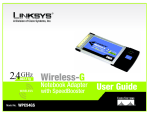Download Microsoft Windows Media Center Extender User guide
Transcript
® A Division of Cisco Systems, Inc. Dual-Band 5 GHz 2.4 GHz 802.11a 802.11g Dual-Band Wireless A/G Media Center Extender WIRELESS Model No. WMCE54AG User Guide Dual-Band Wireless A/G Media Center Extender Copyrights and Trademarks Specifications are subject to change without notice. Linksys is a registered trademark or trademark of Cisco Systems, Inc. and/or its affiliates in the U.S. and certain other countries. Copyright © 2004 Cisco Systems, Inc. All rights reserved. Other brands and product names are trademarks or registered trademarks of their respective holders. Microsoft and Windows are registered trademarks of Microsoft Corporation in the U.S.A. and/or other countries. This product is protected by certain intellectual property rights of Microsoft Corporation. Use or distribution of such technology outside of this product is prohibited without a license from Microsoft Corporation or an authorized Microsoft Corporation subsidiary. WARNING: This product contains chemicals, including lead, known to the State of California to cause cancer, and birth defects or other reproductive harm. Wash hands after handling. How to Use this Guide Your guide to the Media Center Extender has been designed to make understanding networking with the Extender easier than ever. Look for the following items when reading this User Guide: This exclamation point means there is a caution or warning and is something that could damage your property or the Extender. This question mark provides you with a reminder about something you might need to do while using the Extender. This checkmark means there is a note of interest and is something you should pay special attention to while using the Extender. In addition to these symbols, there are definitions for technical terms that are presented like this: word: definition. Also, each figure (diagram, screenshot, or other image) is provided with a figure number and description, like this: Figure 0-1: Sample Figure Description Figure numbers and descriptions can also be found in the “List of Figures” section. WMCE54AG-UG-41029B JL Dual-Band Wireless A/G Media Center Extender Dual-Band Wireless A/G Media Center Extender Table of Contents Chapter 1: Introduction 1 Welcome What’s in this Guide? 1 1 Chapter 2: Getting to Know the Media Center Extender Front Panel Back Panel Remote Control 3 3 5 8 Chapter 3: Connecting the Media Center Extender 11 Before You Begin Instructions for Connecting to a Wired Network Instructions for Connecting the Extender 11 12 13 Chapter 4: Setting up the Media Center Extender Appendix A: Troubleshooting 17 19 Common Problems and Solutions Frequently Asked Questions Appendix B: Wireless Security Security Precautions Security Threats Facing Wireless Networks Appendix C: Updating the Extender’s Software Image Appendix D: Windows Help Appendix E: Glossary Appendix F: Specifications Appendix G: Warranty Information Appendix H: Regulatory Information Appendix I: Contact Information 19 22 25 25 26 29 31 33 43 45 47 49 Dual-Band Wireless A/G Media Center Extender List of Figures Figure 2-1: Front Panel Figure 2-2: Back Panel Figure 2-3: Remote Control Figure 3-1: Wireless Network Figure 3-2: Connect the Ethernet Network Cable Figure 3-3: Connect the Composite or S-Video Cable Figure 3-4: Connect the Component Video Cables Figure 3-5: Connect the Analog Audio Cables Figure 3-6: Connect the Digital Audio Cable Figure 3-7: Power on the Extender Figure 3-8: Press the Power Button Figure 3-9: Check the POWER Switch Figure 4-1: Write down the Setup Key Figure 4-2: Insert the Setup CD Figure 4-3: Enter the Setup Key 3 5 8 11 12 13 13 14 14 15 15 15 17 17 18 Dual-Band Wireless A/G Media Center Extender Chapter 1: Introduction Welcome Thank you for choosing the Dual-Band Wireless A/G Media Center Extender. The Extender lets you send digital video, pictures, and music from your Media Center PC to your TV, without running cables through the house. Plus you get to watch and pause live TV shows, or you can digitally record them so you can watch them later. How does the Extender do all of this? It sits by your home TV and connects to it using standard video and audio cables. Then it connects to your home network via Wireless-A (802.11a) or Wireless-G (802.11g) networking, or if you prefer, it can be connected via standard 10/100 Ethernet cabling. Using the Extender’s remote control and the user-friendly TV menus, you can browse through TV listings, recordings, digital music tracks, and more. Use the instructions in this User Guide to help you integrate the Extender into your network. These instructions should be all you need to get the most out of the Dual-Band Wireless A/G Media Center Extender. What’s in this Guide? This user guide covers the steps for setting up and using the Extender. • Chapter 1: Introduction This chapter describes the Extender’s applications and this User Guide. • Chapter 2: Getting to Know the Media Center Extender This chapter describes the physical features of the Extender and its remote control. • Chapter 3: Connecting the Media Center Extender This chapter explains how to connect the Extender. Chapter 1: Introduction Welcome 802.11a: a wireless networking standard that specifies a maximum data transfer rate of 54Mbps and an operating frequency of 5GHz. 802.11g: a wireless networking standard that specifies a maximum data transfer rate of 54Mbps, an operating frequency of 2.4GHz, and backward compatibility with 802.11b devices. ethernet: an IEEE standard network protocol that specifies how data is placed on and retrieved from a common transmission medium. 1 Dual-Band Wireless A/G Media Center Extender • Chapter 4: Setting up the Media Center Extender This chapter explains how to set up the Extender. • Appendix A: Troubleshooting This appendix describes some potential problems and solutions, as well as frequently asked questions, regarding installation and use of the Extender. • Appendix B: Wireless Security This appendix discusses security issues regarding wireless networking and measures you can take to help protect your wireless network. • Appendix C: Updating the System Image This appendix explains how to update the Extender’s software image. • Appendix D: Windows Help This appendix describes how you can use Windows Help for instructions about networking, such as installing the TCP/IP protocol. • Appendix E: Glossary This appendix gives a brief glossary of terms frequently used in networking. • Appendix F: Specifications This appendix provides the technical specifications for the Extender. • Appendix G: Warranty Information This appendix supplies the warranty information for the Extender. • Appendix H: Regulatory Information This appendix supplies the regulatory information regarding the Extender. • Appendix I: Contact Information This appendix provides contact information for a variety of Linksys resources, including Technical Support. 2 Chapter 1: Introduction What’s in this Guide? Dual-Band Wireless A/G Media Center Extender Chapter 2: Getting to Know the Media Center Extender Front Panel You can control the Extender through the front panel buttons or the remote control. The menus will be displayed on the TV screen. Start Infrared LED Button Navigation Pad with LED ENTER BACK Button Button Standby Button Figure 2-1: Front Panel Infrared The infrared receiver accepts signals transmitted from the remote control. LED Red. This LED will light up every time the Extender receives a command from the remote control. Start Button Press the square green button to view the main menu of the Extender. Chapter 2: Getting to Know the Media Center Extender Front Panel 3 Dual-Band Wireless A/G Media Center Extender Navigation Pad with LED Press the left, right, up, or down arrows to navigate through the menus displayed on the TV screen. To indicate the status of the Extender, the LED can display one of three colors: green, blue, and red. Green. The Navigation Pad LED will light up green when the Extender is booting up and working properly. The green LED will flash quickly when the Extender is updating its software image. Blue. The blue Navigation Pad LED will flash quickly when the Extender is resetting itself or restoring its software image. Red. The red Navigation Pad LED will flash quickly when a system failure has occurred. Enter Button Use the Enter button to make a selection from the menus displayed on the TV screen. Back Button Use the Back button to move back through the menus displayed on the TV screen. Standby Button Press the Standby button to put the Extender in power-saving standby mode. Press this button again to use the Extender. After exiting standby mode, the Extender will re-establish its connection with the Media Center PC. (This may take several seconds.) 4 Chapter 2: Getting to Know the Media Center Extender Front Panel Dual-Band Wireless A/G Media Center Extender Back Panel On the Media Center Extender’s back panel, you have an attached power cord, switches, various ports, an attached antenna, and an Ethernet button. Components Power Cord The power cord is attached to the Extender. POWER Switch The POWER switch powers on or off the Extender. IR-OUT Port The IR Out port is not used at this time. POWER Switch Power Cord DIGITAL Audio Port VIDEO Port VIDEO SELECT Switch IR-OUT Audio (L and R) S-VIDEO Port Port Ports USB Ports COMPONENT VIDEO Ports Antenna Ethernet Port Ethernet Button Figure 2-2: Back Panel Chapter 2: Getting to Know the Media Center Extender Back Panel 5 Dual-Band Wireless A/G Media Center Extender AUDIO The Extender offers two types of audio outputs, digital and analog. In most cases, you will use the AUDIO (L and R) ports for analog audio; however, you have the option of digital audio if your TV offers a digital input. DIGITAL The DIGITAL port is where you will connect the optical cable for digital audio output. AUDIO (L and R) The L and R ports are where you will connect the left and right RCA audio cables. VIDEO The Extender offers three types of video outputs: composite (VIDEO port), S-video, and component video. In most cases, you will use the VIDEO or S-VIDEO port; however, you have the option of component video if your TV offers a component video input. VIDEO The VIDEO port is where you will connect the RCA video cable. S-VIDEO The S-VIDEO port is where you will connect the S-video cable. VIDEO SELECT Use this switch to indicate the type of video the Extender is sending to your TV. For video or S-video, set this switch to the left. For component video, then set this switch to the right. NOTE: Make sure the Extender is powered off before changing the position of this switch. COMPONENT VIDEO 6 These ports are where you will connect the component video cables (not included). Chapter 2: Getting to Know the Media Center Extender Back Panel Dual-Band Wireless A/G Media Center Extender Additional Components USB Ports The USB ports are not used at this time. Ethernet Port The Ethernet port is where you will connect the Ethernet network cable if you are using a wired Ethernet network. Ethernet Button Press this button if the Extender is having difficulty communicating with your Media Center PC over a wired Ethernet network. Antenna The antenna is permanently attached to the Extender. Chapter 2: Getting to Know the Media Center Extender Back Panel 7 Dual-Band Wireless A/G Media Center Extender Remote Control The Extender includes a remote control. When you first want to use the remote, insert the included AA batteries into the battery compartment. Then use the remote to navigate through menus and make selections on the TV screen, as well as control slide shows, video, or music. Here are descriptions of the remote’s various buttons: (Power) This powers the Extender on or off. My TV Press this button to view the My TV menu. My Music Press this button to view the My Music menu. My Pictures Press this button to view the My Pictures menu. My Videos Press this button to view the My Videos menu. RECORD This starts or stops a video recording. STOP This stops the selection being played. (Play) This starts the selection being played. PAUSE This pauses the selection being played. REW Press this button to rewind the selection being played.* FWD Press this button to forward the selection being played.* *disabled for video 8 Figure 2-3: Remote Control Chapter 2: Getting to Know the Media Center Extender Remote Control Dual-Band Wireless A/G Media Center Extender REPLAY Press this button to replay your selection. SKIP Press this button to skip the next selection. BACK Press this button to go back through the menus. MORE Press this button to get additional information. OK (and arrows) Use the arrow buttons to move through menus. Use the OK button to make a selection. VOL Press this button to raise or lower the volume of your TV or stereo. Start Button Press the square green button to view the Media Center Start screen. CH/PG Use these buttons to change the channel on the TV or page through an extensive menu. MUTE Press this button to mute the sound on the TV or stereo. RECORDED TV Press this button to view the Recorded TV menu. GUIDE Pressing this button displays the Program Guide for live TV. LIVE TV Press this button if you want to watch live TV. DVD MENU This button is not available at this time. 1-9, *, # Use these buttons to enter a channel number. CLEAR Press this button to clear a selection or entry you have made. ENTER Press this button after you have entered a channel number or made a selection. Chapter 2: Getting to Know the Media Center Extender Remote Control 9 Dual-Band Wireless A/G Media Center Extender 10 Chapter 2: Getting to Know the Media Center Extender Remote Control Dual-Band Wireless A/G Media Center Extender Chapter 3: Connecting the Media Center Extender Before You Begin For the Extender to work properly, make sure you have the following: • A PC running Windows® XP Media Center Edition 2005 • A wired network OR a Wireless-A (802.11a), Wireless-G (802.11g), or Wireless A+G (802.11a + 802.11g) network (A Wireless-B (802.11b) network will not work with the Media Center Extender.) If the Extender will connect to a wired network, start with the “Instructions for Connecting to a Wired Network” section. If the Extender will connect to a wireless network, proceed to the “Instructions for Connecting the Extender” section. Figure 3-1: Wireless Network Chapter 3: Connecting the Media Center Extender Before You Begin 11 Dual-Band Wireless A/G Media Center Extender Instructions for Connecting to a Wired Network 1. Connect the included Ethernet network cable from the Extender’s Ethernet port to an Ethernet network port on your Media Center PC, router, or switch. 2. The Extender’s Ethernet port includes an LED in one corner. It will light up when the Extender has successfully joined your wired network. If the LED does not light up, push the Extender’s Ethernet X-II button on the back panel. 3. Proceed to the “Instructions for Connecting the Extender” section. Figure 3-2: Connect the Ethernet Network Cable 12 Chapter 3: Connecting the Media Center Extender Instructions for Connecting to a Wired Network Dual-Band Wireless A/G Media Center Extender Instructions for Connecting the Extender 1. If you are using composite or S-video, connect the video cable from the Extender’s VIDEO output to your TV’s VIDEO input. Then make sure the VIDEO SELECT switch is set to the left. If you are using component video, connect the component video cables (not included) from the Extender’s COMPONENT VIDEO output to your TV’s COMPONENT VIDEO input. Then make sure the VIDEO SELECT switch is set to the right. NOTE: Make sure the Extender is powered off before changing the position of this switch. OR OR Figure 3-3: Connect the Composite or S-Video Cable Chapter 3: Connecting the Media Center Extender Instructions for Connecting the Extender Figure 3-4: Connect the Component Video Cables 13 Dual-Band Wireless A/G Media Center Extender 2. If you are using analog audio, connect the RCA audio cable from the Extender’s left and right AUDIO outputs to your TV’s AUDIO inputs. If you are using a stereo with digital audio, connect the Toslink optical cable (not included) from the Extender’s SPDIF digital AUDIO output to your stereo’s digital AUDIO input. OR Figure 3-5: Connect the Analog Audio Cables 14 Figure 3-6: Connect the Digital Audio Cable Chapter 3: Connecting the Media Center Extender Instructions for Connecting the Extender Dual-Band Wireless A/G Media Center Extender 3. Plug the Extender’s power cord into an electrical outlet. Figure 3-7: Power on the Extender 4. The Extender will automatically power on. If it does not, press the standby button on the Extender’s front panel, and then check the POWER switch on the Extender’s back panel. Proceed to “Chapter 4: Setting up the Media Center Extender.” Figure 3-8: Press the Power Button Chapter 3: Connecting the Media Center Extender Instructions for Connecting the Extender Figure 3-9: Check the POWER Switch 15 Dual-Band Wireless A/G Media Center Extender 16 Chapter 3: Connecting the Media Center Extender Instructions for Connecting the Extender Dual-Band Wireless A/G Media Center Extender Chapter 4: Setting up the Media Center Extender 1. Power on your TV, and select the video input that displays the Extender’s Setup Key Screen (press the INPUT, SOURCE, or TV/VIDEO button on your TV’s remote control). 2. Write down the Setup Key. You will need to enter it when your Media Center PC asks for the Setup Key. Figure 4-1: Write down the Setup Key 3. Go to your Media Center PC and insert the Windows Media Center Extender Setup CD into the CD drive. Figure 4-2: Insert the Setup CD Chapter 4: Setting up the Media Center Extender 17 Dual-Band Wireless A/G Media Center Extender 4. The Media Center Extender Setup wizard will automatically run. When the Media Center PC asks you for the Setup Key, enter the Setup Key you previously wrote down. 5. Follow the on-screen instructions displayed by the Media Center PC. Figure 4-3: Enter the Setup Key 6. If the Media Center PC asks you to enter wireless settings for the Extender, use the remote control’s navigation pad to enter settings. If you need more information about the remote control, refer to “Chapter 2: Getting to Know the Media Center Extender.” Congratulations! The installation of the Media Center Extender is complete. 18 Chapter 4: Setting up the Media Center Extender Dual-Band Wireless A/G Media Center Extender Appendix A: Troubleshooting This appendix provides solutions to problems that may occur during the installation and operation of the Extender. Read the description below to solve your problems. If you can't find an answer here, check the Linksys website at www.linksys.com. Common Problems and Solutions 1. I’ve connected the Extender to my TV, and I see an error code on the screen. When an error has occurred, you will see a picture of the Extender and a book, with a numbered triangle in the lower left-hand corner. Look at the number in the triangle, and refer to the table below for your solution. Error Code Error Solution 1 The Extender is malfunctioning. Contact Linksys for technical support. 2 The Media Center Extender’s software image is damaged or missing. Restore the Extender’s software image. Refer to Problem #2 for instructions. 3 The Extender’s software image is faulty, or the Media Center PC is not in the proper mode to restore the Extender’s software image. Restore the Extender’s software image. Refer to Problem #2 for instructions. 4 There is a problem with the Ethernet network cable connection. Make sure the network cable is properly connected, or replace it with another one. Appendix A: Troubleshooting Common Problems and Solutions 19 Dual-Band Wireless A/G Media Center Extender 2. I need to restore the Extender’s software image. You can restore the Extender’s software image to its factory defaults; however, if you do so, you will lose any custom settings you may have configured. (Before you restore its software image, write down all of your custom settings.) Do NOT restore the software image unless you are sure this is necessary. To restore the Extender’s software image, follow these instructions: A. On the back panel of the Extender, set the power switch to the OFF position. B. Press and hold down the standby button on the front panel. While holding down the standby button, set the power switch to the ON position. C. When the Navigation Pad LED flashes green, release the standby button and then immediately press the standby button once. D. The Navigation Pad LED will flash yellow as the Extender’s software image is restored. E. When the software image has been restored, follow the instructions in “Chapter 4: Setting up the Media Center Extender” to set up the Extender. F. Use your Media Center PC to enter any custom settings you may have configured. If you need more information, refer to the documentation for the Media Center PC. 3. I need to update the Extender’s software image. To update the Extender’s software image, follow these instructions: A. Download the Extender’s software image update file from the Linksys website, www.linksys.com. B. Extract the zip file on your Media Center PC and save the Extender’s .mcx file. C. Double-click the .mcx file, and follow the on-screen instructions. D. After the software image has been updated, use your Media Center PC to enter any custom settings you may have configured. If you need more information, refer to the documentation for the Media Center PC. 20 Appendix A: Troubleshooting Common Problems and Solutions Dual-Band Wireless A/G Media Center Extender 4. When I use the Extender on my wireless network, I see choppy video and dropped frames, or I hear choppy audio and distorted sounds. Follow these instructions until your problem is solved: A. You may be using a Wireless-B (802.11b) network, which is not supported by the Extender. Make sure the Extender is connected to a Wireless-A (802.11a) or Wireless-G (802.11g) network. (A Wireless-A network is recommended.) B. If you are using a Wireless-G network, your network may be experiencing interference caused by a microwave or 2.4 GHz cordless phones. If possible, move the wireless router away from your microwave or 2.4GHz cordless phones. (If your 2.4GHz cordless phones cause interference, you may want to switch to 900MHz or 5GHz cordless phones.) C. You may be using a “double hop” wireless network, which is not supported by the Extender. (A “double hop network” is a network in which both the Media Center PC and Extender communicate with the wireless router via wireless.) Make sure at least one of the devices, the Extender or the Media Center PC, is connected to the wireless router using an Ethernet network cable. D. Check the Media Center PC to see if it has sufficient system resources available for use by the Extender. If you need more information, refer to the documentation for the Media Center PC. E. Change the channel that your wireless network uses. For instructions on how to change the channel setting, refer to the documentation for the wireless router. F. If your wireless network is still experiencing performance and interference problems, visit http://www.microsoft.com/windowsxp/mediacenter/evaluation/devices/networkperf.mspx for Microsoft’s suggestions about maximizing wireless network performance. Appendix A: Troubleshooting Common Problems and Solutions 21 Dual-Band Wireless A/G Media Center Extender Frequently Asked Questions What version of Windows XP Media Center do I need? You must use Windows XP Media Center Edition 2005. The Extender does not support previous versions. I don’t have Windows XP Media Center Edition 2005, but I do have a previous version. How do I get an upgrade? For more information, contact the manufacturer of your Media Center PC. If you are not sure how to contact the manufacturer, visit www.microsoft.com/mceupgrade for contact information. Can I use the Extender with a Wireless-B (802.11b) network? No, Wireless-B networking is not supported by the Extender. It will work with a Wireless-A (802.11a) or Wireless-G (802.11g) network. What is a “double hop” wireless network? It is a network in which both the Media Center PC and Extender are connected to the wireless router via wireless. This type of network is not supported and may cause choppy video or frequent drop-outs. For best results, use an Ethernet network cable to connect either the Media Center PC or Extender to the wireless router. What is the IEEE 802.11a standard? It is one of the IEEE standards for wireless networks. The 802.11a standard allows wireless networking hardware from different manufacturers to communicate, provided that the hardware complies with the 802.11a standard. The 802.11a standard states a maximum data transfer rate of 54Mbps and an operating frequency of 5GHz. 22 Appendix A: Troubleshooting Frequently Asked Questions Dual-Band Wireless A/G Media Center Extender What is the IEEE 802.11g standard? It is one of the IEEE standards for wireless networks. The 802.11g standard allows wireless networking hardware from different manufacturers to communicate, provided that the hardware complies with the 802.11g standard. The 802.11g standard states a maximum data transfer rate of 54Mbps and an operating frequency of 2.4GHz. What IEEE 802.11a features are supported? The product supports the following IEEE 802.11a functions: • OFDM protocol • Multi-Channel Roaming • Automatic Rate Selection • RTS/CTS feature • Fragmentation What IEEE 802.11g features are supported? The product supports the following IEEE 802.11g functions: • CSMA/CA plus Acknowledge protocol • OFDM protocol • Multi-Channel Roaming • Automatic Rate Selection • RTS/CTS feature • Fragmentation • Power Management Appendix A: Troubleshooting Frequently Asked Questions 23 Dual-Band Wireless A/G Media Center Extender What is ad-hoc mode? When a wireless network is set to ad-hoc mode, the wireless-equipped computers are configured to communicate directly with each other. The ad-hoc wireless network will not communicate with any wired network. What is infrastructure mode? When a wireless network is set to infrastructure mode, the wireless network is configured to communicate with a wired network through a wireless access point or router. 24 Appendix A: Troubleshooting Frequently Asked Questions Dual-Band Wireless A/G Media Center Extender Appendix B: Wireless Security Linksys wants to make wireless networking as safe and easy for you as possible. The current generation of Linksys products provide several network security features, but they require specific action on your part for implementation. So, keep the following in mind whenever you are setting up or using your wireless network. Security Precautions The following is a complete list of security precautions to take: 1. Change the default SSID. 2. Disable SSID Broadcast. 3. Change the default password for the Administrator account. 4. Enable MAC Address Filtering. 5. Change the SSID periodically. 6. Use the highest encryption algorithm possible. Use WPA if it is available. Please note that this may reduce your network performance. NOTE: Some of these security features are available only through the network router or access point. Refer to the router or access point’s documentation for more information. 7. Change the WEP encryption keys periodically. To ensure network security, steps one through five should be followed, at least. Appendix B: Wireless Security Security Precautions 25 Dual-Band Wireless A/G Media Center Extender Security Threats Facing Wireless Networks Wireless networks are easy to find. Hackers know that in order to join a wireless network, wireless networking products first listen for “beacon messages”. These messages can be easily decrypted and contain much of the network’s information, such as the network’s SSID (Service Set Identifier). Here are the steps you can take: Change the administrator’s password regularly. With every wireless networking device you use, keep in mind that network settings (SSID, WEP keys, etc.) are stored in its firmware. Your network administrator is the only person who can change network settings. If a hacker gets a hold of the administrator’s password, he, too, can change those settings. So, make it harder for a hacker to get that information. Change the administrator’s password regularly. SSID. There are several things to keep in mind about the SSID: 1. Disable Broadcast 2. Make it unique 3. Change it often Most wireless networking devices will give you the option of broadcasting the SSID. While this option may be more convenient, it allows anyone to log into your wireless network. This includes hackers. So, don’t broadcast the SSID. Wireless networking products come with a default SSID set by the factory. (The Linksys default SSID is “linksys”.) Hackers know these defaults and can check these against your network. Change your SSID to something unique and not something related to your company or the networking products you use. 26 Appendix B: Wireless Security Security Threats Facing Wireless Networks Dual-Band Wireless A/G Media Center Extender Change your SSID regularly so that any hackers who have gained access to your wireless network will have to start from the beginning in trying to break in. MAC Addresses. Enable MAC Address filtering. MAC Address filtering will allow you to provide access to only those wireless nodes with certain MAC Addresses. This makes it harder for a hacker to access your network with a random MAC Address. WEP Encryption. Wired Equivalent Privacy (WEP) is often looked upon as a cure-all for wireless security concerns. This is overstating WEP’s ability. Again, this can only provide enough security to make a hacker’s job more difficult. There are several ways that WEP can be maximized: 1. Use the highest level of encryption possible IMPORTANT: Always remember that each device in your wireless network MUST use the same encryption method and encryption key or your wireless network will not function properly. 2. Use “Shared Key” authentication 3. Change your WEP key regularly WPA. Wi-Fi Protected Access (WPA) is the newest and best available standard in Wi-Fi security. Two modes are available: Pre-Shared Key and RADIUS. Pre-Shared Key gives you a choice of two encryption methods: TKIP (Temporal Key Integrity Protocol), which utilizes a stronger encryption method and incorporates Message Integrity Code (MIC) to provide protection against hackers, and AES (Advanced Encryption System), which utilizes a symmetric 128-Bit block data encryption. RADIUS (Remote Authentication Dial-In User Service) utilizes a RADIUS server for authentication and the use of dynamic TKIP, AES, or WEP. WPA Pre-Shared Key. If you do not have a RADIUS server, select the type of algorithm, TKIP or AES, enter a password in the Pre-Shared key field of 8-64 characters, and enter a Group Key Renewal period time Appendix B: Wireless Security Security Threats Facing Wireless Networks 27 Dual-Band Wireless A/G Media Center Extender between 0 and 99,999 seconds, which instructs the Router or other device how often it should change the encryption keys. WPA RADIUS. WPA used in coordination with a RADIUS server. (This should only be used when a RADIUS server is connected to the Router or other device.) First, select the type of WPA algorithm, TKIP or AES. Enter the RADIUS server’s IP Address and port number, along with a key shared between the device and the server. Last, enter a Group Key Renewal period, which instructs the device how often it should change the encryption keys. RADIUS. WEP used in coordination with a RADIUS server. (This should only be used when a RADIUS server is connected to the Router or other device.) First, enter the RADIUS server’s IP Address and port number, along with a key shared between the device and the server. Then, select a WEP key and a level of WEP encryption, and either generate a WEP key through the Passphrase or enter the WEP key manually. Implementing encryption may have a negative impact on your network’s performance, but if you are transmitting sensitive data over your network, encryption should be used. These security recommendations should help keep your mind at ease while you are enjoying the most flexible and convenient technology Linksys has to offer. 28 Appendix B: Wireless Security Security Threats Facing Wireless Networks Dual-Band Wireless A/G Media Center Extender Appendix C: Updating the Extender’s Software Image You can update the Extender’s software image; however, if you do so, you will lose the custom settings you may have configured on the Extender. Before you update its software image, write down all of your custom settings, including the wireless ones if the Extender works with a wireless network. After you update its software image, you will have to re-enter all of your custom settings. To update the Extender’s software image, follow these instructions: 1. Download the Extender’s software image update file from the Linksys website, www.linksys.com. 2. Extract the zip file on your Media Center PC and save the Extender’s .mcx file. 3. Double-click the .mcx file, and follow the on-screen instructions. Appendix C: Updating the Extender’s Software Image 29 Dual-Band Wireless A/G Media Center Extender 30 Appendix C: Updating the Extender’s Software Image Dual-Band Wireless A/G Media Center Extender Appendix D: Windows Help Almost all Linksys products require Microsoft® Windows. Windows is the most used operating system in the world and comes with many features that help make networking easier. These features can be accessed through Windows Help and are described in this appendix. TCP/IP Before a computer can communicate with a network router, TCP/IP must be enabled. TCP/IP is a set of instructions, or protocol, all PCs follow to communicate over a network. This is true for wireless networks as well. Your PCs will not be able to utilize wireless networking without having TCP/IP enabled. Windows Help provides complete instructions on enabling TCP/IP. Shared Resources If you wish to share printers, folder, or files over your network, Windows Help provides complete instructions on utilizing shared resources. Network Neighborhood/My Network Places Other PCs on your network will appear under Network Neighborhood or My Network Places (depending upon the version of Windows you're running). Windows Help provides complete instructions on adding PCs to your network. Appendix D: Windows Help 31 Dual-Band Wireless A/G Media Center Extender 32 Appendix D: Windows Help Dual-Band Wireless A/G Media Center Extender Appendix E: Glossary 802.11a - A wireless networking standard that specifies a maximum data transfer rate of 54Mbps and an operating frequency of 5GHz. 802.11b - A wireless networking standard that specifies a maximum data transfer rate of 11Mbps and an operating frequency of 2.4GHz. 802.11g - A wireless networking standard that specifies a maximum data transfer rate of 54Mbps, an operating frequency of 2.4GHz, and backward compatibility with 802.11b devices. Access Point - A device that allows wireless-equipped computers and other devices to communicate with a wired network. Also used to expand the range of a wireless network. Adapter - A device that adds network functionality to your PC. Ad-hoc - A group of wireless devices communicating directly with each other (peer-to-peer) without the use of an access point. AES (Advanced Encryption Standard) - A security method that uses symmetric 128-bit block data encryption. Backbone - The part of a network that connects most of the systems and networks together, and handles the most data. Bandwidth - The transmission capacity of a given device or network. Beacon Interval - Data transmitted on your wireless network that keeps the network synchronized. Appendix E: Glossary 33 Dual-Band Wireless A/G Media Center Extender Bit - A binary digit. Boot - To start a device and cause it to start executing instructions. Bridge - A device that connects different networks. Broadband - An always-on, fast Internet connection. Browser - An application program that provides a way to look at and interact with all the information on the World Wide Web. Buffer - A shared or assigned memory area that is used to support and coordinate different computing and networking activities so one isn't held up by the other. Byte - A unit of data that is usually eight bits long Cable Modem - A device that connects a computer to the cable television network, which in turn connects to the Internet. CSMA/CA (Carrier Sense Multiple Access/Collision Avoidance) - A method of data transfer that is used to prevent data collisions. CTS (Clear To Send) - A signal sent by a wireless device, signifying that it is ready to receive data. Daisy Chain - A method used to connect devices in a series, one after the other. Database - A collection of data that is organized so that its contents can easily be accessed, managed, and updated. 34 Appendix E: Glossary Dual-Band Wireless A/G Media Center Extender DDNS (Dynamic Domain Name System) - Allows the hosting of a website, FTP server, or e-mail server with a fixed domain name (e.g., www.xyz.com) and a dynamic IP address. Default Gateway - A device that forwards Internet traffic from your local area network. DHCP (Dynamic Host Configuration Protocol) - A networking protocol that allows administrators to assign temporary IP addresses to network computers by “leasing” an IP address to a user for a limited amount of time, instead of assigning permanent IP addresses. DMZ (Demilitarized Zone) - Removes the Router's firewall protection from one PC, allowing it to be “seen” from the Internet. DNS (Domain Name Server) - The IP address of your ISP's server, which translates the names of websites into IP addresses. Domain - A specific name for a network of computers. Download - To receive a file transmitted over a network. DSL (Digital Subscriber Line) - An always-on broadband connection over traditional phone lines. DSSS (Direct-Sequence Spread-Spectrum) - Frequency transmission with a redundant bit pattern resulting in a lower probability of information being lost in transit. DTIM (Delivery Traffic Indication Message) - A message included in data packets that can increase wireless efficiency. Dynamic IP Address - A temporary IP address assigned by a DHCP server. Appendix E: Glossary 35 Dual-Band Wireless A/G Media Center Extender EAP (Extensible Authentication Protocol) - A general authentication protocol used to control network access. Many specific authentication methods work within this framework. EAP-PEAP (Extensible Authentication Protocol-Protected Extensible Authentication Protocol) - A mutual authentication method that uses a combination of digital certificates and another system, such as passwords. EAP-TLS (Extensible Authentication Protocol-Transport Layer Security) - A mutual authentication method that uses digital certificates. Encryption - Encoding data transmitted in a network. Ethernet - A networking protocol that specifies how data is placed on and retrieved from a common transmission medium. Finger - A program that tells you the name associated with an e-mail address. Firewall - A set of related programs located at a network gateway server that protects the resources of a network from users from other networks. Firmware - The programming code that runs a networking device. Fragmentation -Breaking a packet into smaller units when transmitting over a network medium that cannot support the original size of the packet. FTP (File Transfer Protocol) - A protocol used to transfer files over a TCP/IP network. Full Duplex - The ability of a networking device to receive and transmit data simultaneously. Gateway - A device that interconnects networks with different, incompatible communications protocols. 36 Appendix E: Glossary Dual-Band Wireless A/G Media Center Extender Half Duplex - Data transmission that can occur in two directions over a single line, but only one direction at a time. Hardware - The physical aspect of computers, telecommunications, and other information technology devices. HTTP (HyperText Transport Protocol) - The communications protocol used to connect to servers on the World Wide Web. Infrastructure - A wireless network that is bridged to a wired network via an access point. IP (Internet Protocol) - A protocol used to send data over a network. IP Address - The address used to identify a computer or device on a network. IPCONFIG - A Windows 2000 and XP utility that displays the IP address for a particular networking device. IPSec (Internet Protocol Security) - A VPN protocol used to implement secure exchange of packets at the IP layer. ISM band - Radio bandwidth utilized in wireless transmissions. ISP (Internet Service Provider) - A company that provides access to the Internet. LAN - The computers and networking products that make up your local network. LEAP (Lightweight Extensible Authentication Protocol) - A mutual authentication method that uses a username and password system. MAC (Media Access Control) Address - The unique address that a manufacturer assigns to each networking device. Appendix E: Glossary 37 Dual-Band Wireless A/G Media Center Extender Mbps (MegaBits Per Second) - One million bits per second; a unit of measurement for data transmission. mIRC - An Internet Relay Chat program that runs under Windows. Multicasting - Sending data to a group of destinations at once. NAT (Network Address Translation) - NAT technology translates IP addresses of a local area network to a different IP address for the Internet. Network - A series of computers or devices connected for the purpose of data sharing, storage, and/or transmission between users. NNTP (Network News Transfer Protocol) - The protocol used to connect to Usenet groups on the Internet. Node - A network junction or connection point, typically a computer or work station. OFDM (Orthogonal Frequency Division Multiplexing) - Frequency transmission that separates the data stream into a number of lower-speed data streams, which are then transmitted in parallel to prevent information from being lost in transit. Packet - A unit of data sent over a network. Passphrase - Used much like a password, a passphrase simplifies the WEP encryption process by automatically generating the WEP encryption keys for Linksys products. Ping (Packet INternet Groper) - An Internet utility used to determine whether a particular IP address is online. POP3 (Post Office Protocol 3) - A standard mail server commonly used on the Internet. Port - The connection point on a computer or networking device used for plugging in cables or adapters. 38 Appendix E: Glossary Dual-Band Wireless A/G Media Center Extender Power over Ethernet (PoE) - A technology enabling an Ethernet network cable to deliver both data and power. PPPoE (Point to Point Protocol over Ethernet) - A type of broadband connection that provides authentication (username and password) in addition to data transport. PPTP (Point-to-Point Tunneling Protocol) - A VPN protocol that allows the Point to Point Protocol (PPP) to be tunneled through an IP network. This protocol is also used as a type of broadband connection in Europe. Preamble - Part of the wireless signal that synchronizes network traffic. RADIUS (Remote Authentication Dial-In User Service) - A protocol that uses an authentication server to control network access. RJ-45 (Registered Jack-45) - An Ethernet connector that holds up to eight wires. Roaming - The ability to take a wireless device from one access point's range to another without losing the connection. Router - A networking device that connects multiple networks together. RTS (Request To Send) - A networking method of coordinating large packets through the RTS Threshold setting. Server - Any computer whose function in a network is to provide user access to files, printing, communications, and other services. SMTP (Simple Mail Transfer Protocol) - The standard e-mail protocol on the Internet. SNMP (Simple Network Management Protocol) - A widely used network monitoring and control protocol. Appendix E: Glossary 39 Dual-Band Wireless A/G Media Center Extender Software - Instructions for the computer. A series of instructions that performs a particular task is called a “program”. SOHO (Small Office/Home Office) - Market segment of professionals who work at home or in small offices. SPI (Stateful Packet Inspection) Firewall - A technology that inspects incoming packets of information before allowing them to enter the network. Spread Spectrum - Wideband radio frequency technique used for more reliable and secure data transmission. SSID (Service Set IDentifier) - Your wireless network's name. Static IP Address - A fixed address assigned to a computer or device that is connected to a network. Static Routing - Forwarding data in a network via a fixed path. Subnet Mask - An address code that determines the size of the network. Switch - 1. A data switch that connects computing devices to host computers, allowing a large number of devices to share a limited number of ports. 2. A device for making, breaking, or changing the connections in an electrical circuit. TCP (Transmission Control Protocol) - A network protocol for transmitting data that requires acknowledgement from the recipient of data sent. TCP/IP (Transmission Control Protocol/Internet Protocol) - A set of instructions PCs use to communicate over a network. Telnet - A user command and TCP/IP protocol used for accessing remote PCs. 40 Appendix E: Glossary Dual-Band Wireless A/G Media Center Extender TFTP (Trivial File Transfer Protocol) - A version of the TCP/IP FTP protocol that has no directory or password capability. Throughput - The amount of data moved successfully from one node to another in a given time period. TKIP (Temporal Key Integrity Protocol) - a wireless encryption protocol that provides dynamic encryption keys for each packet transmitted. Topology - The physical layout of a network. TX Rate - Transmission Rate. UDP (User Datagram Protocol) - A network protocol for transmitting data that does not require acknowledgement from the recipient of the data that is sent. Upgrade - To replace existing software or firmware with a newer version. Upload - To transmit a file over a network. URL (Uniform Resource Locator) - The address of a file located on the Internet. VPN (Virtual Private Network) - A security measure to protect data as it leaves one network and goes to another over the Internet. WAN (Wide Area Network)- The Internet. WEP (Wired Equivalent Privacy) - A method of encrypting network data transmitted on a wireless network for greater security. WINIPCFG - A Windows 98 and Me utility that displays the IP address for a particular networking device. Appendix E: Glossary 41 Dual-Band Wireless A/G Media Center Extender WLAN (Wireless Local Area Network) - A group of computers and associated devices that communicate with each other wirelessly. WPA (Wi-Fi Protected Access) - a wireless security protocol using TKIP (Temporal Key Integrity Protocol) encryption, which can be used in conjunction with a RADIUS server. 42 Appendix E: Glossary Dual-Band Wireless A/G Media Center Extender Appendix F: Specifications Model WMCE54G Standards 802.11a, 802.11g, 802.3u Ports Ethernet, USB, Video Out (Composite, S-Video, Component), Audio Out (Analog R/L, SPDIF Optical), IR Out Buttons Power, Standby, MDI/MDI-X, Video Select, Enter, Back, Up, Down, Left, Right Cabling Type CAT 5 Ethernet, RCA Audio, RCA Video, S-Video, Toslink Optical, Component Video LEDs Power, IR Receive Transmit Power 16 dBm Security Features WEP WEP Key Bits 64, 128 Appendix F: Specifications 43 Dual-Band Wireless A/G Media Center Extender Dimensions (W x H x D) 17.00" x 2.00" x 12.25" (431.8 mm x 50.8 mm x 311.2 mm) Unit Weight 5.71 oz. (2.59 kg) Power 100V~240V AC Certifications FCC, UL Operating Temp. -32ºF ~ 104ºF (0ºC ~ 40ºC) Storage Temp. -4ºF ~ 158ºF (-20ºC ~ 70ºC) Operating Humidity 10% ~ 85%, Non-Condensing Storage Humidity 5% ~ 90%, Non-Condensing 44 Appendix F: Specifications Dual-Band Wireless A/G Media Center Extender Appendix G: Warranty Information LIMITED WARRANTY Linksys warrants to You that, for a period of one year (the “Warranty Period”), your Linksys Product will be substantially free of defects in materials and workmanship under normal use. Your exclusive remedy and Linksys' entire liability under this warranty will be for Linksys at its option to repair or replace the Product or refund Your purchase price less any rebates. This limited warranty extends only to the original purchaser. If the Product proves defective during the Warranty Period call Linksys Technical Support in order to obtain a Return Authorization Number, if applicable. BE SURE TO HAVE YOUR PROOF OF PURCHASE ON HAND WHEN CALLING. If You are requested to return the Product, mark the Return Authorization Number clearly on the outside of the package and include a copy of your original proof of purchase. RETURN REQUESTS CANNOT BE PROCESSED WITHOUT PROOF OF PURCHASE. You are responsible for shipping defective Products to Linksys. Linksys pays for UPS Ground shipping from Linksys back to You only. Customers located outside of the United States of America and Canada are responsible for all shipping and handling charges. ALL IMPLIED WARRANTIES AND CONDITIONS OF MERCHANTABILITY OR FITNESS FOR A PARTICULAR PURPOSE ARE LIMITED TO THE DURATION OF THE WARRANTY PERIOD. ALL OTHER EXPRESS OR IMPLIED CONDITIONS, REPRESENTATIONS AND WARRANTIES, INCLUDING ANY IMPLIED WARRANTY OF NONINFRINGEMENT, ARE DISCLAIMED. Some jurisdictions do not allow limitations on how long an implied warranty lasts, so the above limitation may not apply to You. This warranty gives You specific legal rights, and You may also have other rights which vary by jurisdiction. This warranty does not apply if the Product (a) has been altered, except by Linksys, (b) has not been installed, operated, repaired, or maintained in accordance with instructions supplied by Linksys, or (c) has been subjected to abnormal physical or electrical stress, misuse, negligence, or accident. In addition, due to the continual development of new techniques for intruding upon and attacking networks, Linksys does not warrant that the Product will be free of vulnerability to intrusion or attack. TO THE EXTENT NOT PROHIBITED BY LAW, IN NO EVENT WILL LINKSYS BE LIABLE FOR ANY LOST DATA, REVENUE OR PROFIT, OR FOR SPECIAL, INDIRECT, CONSEQUENTIAL, INCIDENTAL OR PUNITIVE DAMAGES, REGARDLESS OF THE THEORY OF LIABILITY (INCLUDING NEGLIGENCE), ARISING OUT OF OR RELATED TO THE USE OF OR INABILITY TO USE THE PRODUCT (INCLUDING ANY SOFTWARE), EVEN IF LINKSYS HAS BEEN ADVISED OF THE POSSIBILITY OF SUCH DAMAGES. Appendix G: Warranty Information 45 Dual-Band Wireless A/G Media Center Extender IN NO EVENT WILL LINKSYS’ LIABILITY EXCEED THE AMOUNT PAID BY YOU FOR THE PRODUCT. The foregoing limitations will apply even if any warranty or remedy provided under this Agreement fails of its essential purpose. Some jurisdictions do not allow the exclusion or limitation of incidental or consequential damages, so the above limitation or exclusion may not apply to You. Please direct all inquiries to: Linksys, P.O. Box 18558, Irvine, CA 92623. 46 Appendix G: Warranty Information Dual-Band Wireless A/G Media Center Extender Appendix H: Regulatory Information FCC STATEMENT This product has been tested and complies with the specifications for a Class B digital device, pursuant to Part 15 of the FCC Rules. These limits are designed to provide reasonable protection against harmful interference in a residential installation. This equipment generates, uses, and can radiate radio frequency energy and, if not installed and used according to the instructions, may cause harmful interference to radio communications. However, there is no guarantee that interference will not occur in a particular installation. If this equipment does cause harmful interference to radio or television reception, which is found by turning the equipment off and on, the user is encouraged to try to correct the interference by one or more of the following measures: • Reorient or relocate the receiving antenna • Increase the separation between the equipment or devices • Connect the equipment to an outlet other than the receiver's • Consult a dealer or an experienced radio/TV technician for assistance Linksys declares that the Dual-Band Wireless A/G Media Center Extender (FCC ID: Q87-WMCE54AG) is limited in channels 1-11 for the 2.4GHz band by the specified firmware, which is controlled in the USA. FCC Caution: Operation within the 5150 to 5250GHz band is restricted to indoor use only. FCC Radiation Exposure Statement This equipment complies with FCC radiation exposure limits set forth for an uncontrolled environment. This equipment should be installed and operated with minimum distance 20 cm between the radiator and your body. SAFETY NOTICES Caution: To reduce the risk of fire, use only No.26 AWG or larger telecommunication line cord. Do not use this product near water, for example, in a wet basement or near a swimming pool. Avoid using this product during an electrical storm. There may be a remote risk of electric shock from lightning. Appendix H: Regulatory Information 47 Dual-Band Wireless A/G Media Center Extender 48 Appendix H: Regulatory Information Dual-Band Wireless A/G Media Center Extender Appendix I: Contact Information Need to contact Linksys? Visit us online for information on the latest products and updates to your existing products at: http://www.linksys.com or ftp.linksys.com Can't find information about a product you want to buy on the web? Do you want to know more about networking with Linksys products? Give our advice line a call at: Or fax your request in to: 800-546-5797 (LINKSYS) 949-823-3002 If you experience problems with any Linksys product, you can call us at: Don't wish to call? You can e-mail us at: 800-326-7114 [email protected] If any Linksys product proves defective during its warranty period, you can call the Linksys Return Merchandise Authorization department for obtaining a Return Authorization Number at: (Details on Warranty and RMA issues can be found in the Warranty Information section in this Guide.) Appendix I: Contact Information 949-823-3000 49 Dual-Band Wireless A/G Media Center Extender 50 Appendix I: Contact Information www.linksys.com


























































